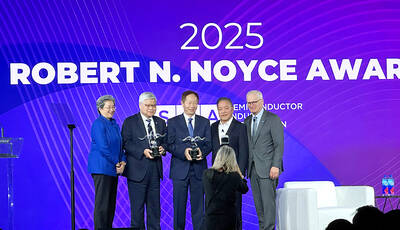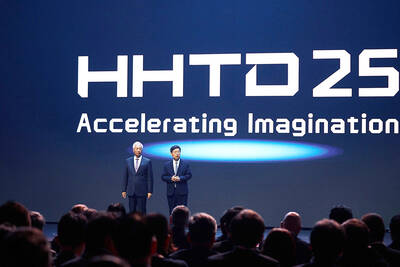A Taipei-based think tank lowered its forecast for the nation’s GDP growth to 0.89 percent for this year, down from the 4.11 percent growth it predicted in early November, on falling exports that are expected to dampen private investment and consumer spending.
The Taiwan Institute of Economic Research (TIER, 台經院) said government investment, which was estimated to rise 23.98 percent, would replace exports to sustain the minor economic growth.
“With an export-dependent economy, the country’s not immune to the blow of the global financial crisis that is dampening demand for Taiwan consumer products,” TIER president David Hong (洪德生) told a morning news conference.
“We expect the GDP growth for this year to narrow to 0.89 percent as the rapid decline in exports has prompted companies to halt or delay expansion, while consumers are tightening belts to cope with job uncertainty. The phenomenon is unfavorable to economic growth,” Hong said.
Against the backdrop, the institute expected GDP to contract 0.83 percent and 0.48 percent in the first and second quarters, respectively, and climb 1.67 percent and 3.13 percent in the third and fourth quarters.
Hong attributed the slow and modest recovery to the stimulus package that was expected to have an impact in the second half, if the government carried out various public works projects effectively.
Private consumption, which accounts for 53 percent of the nation’s GDP, was forecast to edge up 0.67 percent this year, after posting a negative growth of 0.27 percent last year, the TIER report showed.
Exports, critical to economic growth in recent years, were projected to post an annual 2.13 percent growth, the report said, putting the growth figure at minus 5.35 percent and minus 10.22 percent for the first quarter and second quarter, respectively.
Foreign sales were forecast to advance 8.98 percent and 19.15 percent in the third and fourth quarter, the report said.
Chen Miao (陳淼), director of TIER’s macroeconomic forecasting center, said he believed the worst period of the financial crisis was over and the global recession would come to an end this year.
“I believe exports will regain momentum in the second half while economic data will show improvement, owing partly to low base figures last year,” Chen said.
The economist said there was room for upward adjustment as his institute did not factor in the consumer voucher program when updating the GDP forecast.
Before the expected recovery, the business climate grew drabber still as seen in TIER’s monthly survey.
The business climate gauge stood at 75.96 points last month, from 78.01 points in November, the report showed. This is the lowest figure since the institute initiated the survey in March 1979, Chen said.
However, companies bearish about their business prospects dropped 3.6 percent, while firms with bullish sentiment increased from 4.9 percent to 13 percent. Respondents with neutral views rose from 28.4 percent to 40 percent.
“Most respondents say the situation turned out better than expected though firms in the high-tech sector did not share the optimism,” Chen said.

Shiina Ito has had fewer Chinese customers at her Tokyo jewelry shop since Beijing issued a travel warning in the wake of a diplomatic spat, but she said she was not concerned. A souring of Tokyo-Beijing relations this month, following remarks by Japanese Prime Minister Sanae Takaichi about Taiwan, has fueled concerns about the impact on the ritzy boutiques, noodle joints and hotels where holidaymakers spend their cash. However, businesses in Tokyo largely shrugged off any anxiety. “Since there are fewer Chinese customers, it’s become a bit easier for Japanese shoppers to visit, so our sales haven’t really dropped,” Ito

The number of Taiwanese working in the US rose to a record high of 137,000 last year, driven largely by Taiwan Semiconductor Manufacturing Co’s (TSMC, 台積電) rapid overseas expansion, according to government data released yesterday. A total of 666,000 Taiwanese nationals were employed abroad last year, an increase of 45,000 from 2023 and the highest level since the COVID-19 pandemic, data from the Directorate-General of Budget, Accounting and Statistics (DGBAS) showed. Overseas employment had steadily increased between 2009 and 2019, peaking at 739,000, before plunging to 319,000 in 2021 amid US-China trade tensions, global supply chain shifts, reshoring by Taiwanese companies and

Taiwan Semiconductor Manufacturing Co (TSMC) Chairman C.C. Wei (魏哲家) and the company’s former chairman, Mark Liu (劉德音), both received the Robert N. Noyce Award -- the semiconductor industry’s highest honor -- in San Jose, California, on Thursday (local time). Speaking at the award event, Liu, who retired last year, expressed gratitude to his wife, his dissertation advisor at the University of California, Berkeley, his supervisors at AT&T Bell Laboratories -- where he worked on optical fiber communication systems before joining TSMC, TSMC partners, and industry colleagues. Liu said that working alongside TSMC

TECHNOLOGY DAY: The Taiwanese firm is also setting up a joint venture with Alphabet Inc on robots and plans to establish a firm in Japan to produce Model A EVs Manufacturing giant Hon Hai Precision Industry Co (鴻海精密) yesterday announced a collaboration with ChatGPT developer OpenAI to build next-generation artificial intelligence (AI) infrastructure and strengthen its local supply chain in the US to accelerate the deployment of advanced AI systems. Building such an infrastructure in the US is crucial for strengthening local supply chains and supporting the US in maintaining its leading position in the AI domain, Hon Hai said in a statement. Through the collaboration, OpenAI would share its insights into emerging hardware needs in the AI industry with Hon Hai to support the company’s design and development work, as well